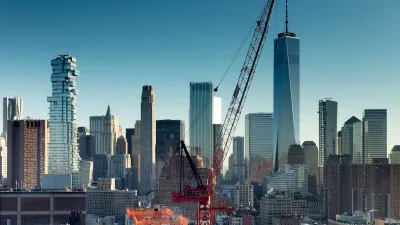A new study makes a visual case against the narrative that spot zoning and a broken development approval process are running roughshod over the entire city.

Steven Sharp shares news of a new study [pdf] released by the UCLA Anderson Forecast and the UCLA Ziman Center for Real Estate that puts the planning and development approvals process in context by aggregating all of Los Angeles' zoning changes for specific parcels, which the study describes as "spot zoning."
The study comes at a time of controversy over the planning process and the impacts of development in the city. The findings of the report, however, probably run counter to the narrative of runaway development preferred by advocates for the Neighborhood Integrity Initiative.
Authored by C.J. Gabbe, the study identifies properties with zoning changes of two kinds: those that allowed for more residential density and those that allowed for less density. Here Gabbe summarizes the findings:
Zoning designations were largely static: On average, the City upzoned 225 acres and downzoned 216 acres annually between 2002 and 2014. (Los Angeles' total land area is about 300,000 acres.) That is less than two-tenths of one percent of its land area every year.
Another provocative layer of conclusion drawn from the report's findings: in Los Angeles, "the most desirable neighborhoods with access to valuable amenities are also the most difficult to upzone."
FULL STORY: When and Where Does Upzoning Actually Happen?

Maui's Vacation Rental Debate Turns Ugly
Verbal attacks, misinformation campaigns and fistfights plague a high-stakes debate to convert thousands of vacation rentals into long-term housing.

Planetizen Federal Action Tracker
A weekly monitor of how Trump’s orders and actions are impacting planners and planning in America.

San Francisco Suspends Traffic Calming Amidst Record Deaths
Citing “a challenging fiscal landscape,” the city will cease the program on the heels of 42 traffic deaths, including 24 pedestrians.

Defunct Pittsburgh Power Plant to Become Residential Tower
A decommissioned steam heat plant will be redeveloped into almost 100 affordable housing units.

Trump Prompts Restructuring of Transportation Research Board in “Unprecedented Overreach”
The TRB has eliminated more than half of its committees including those focused on climate, equity, and cities.

Amtrak Rolls Out New Orleans to Alabama “Mardi Gras” Train
The new service will operate morning and evening departures between Mobile and New Orleans.
Urban Design for Planners 1: Software Tools
This six-course series explores essential urban design concepts using open source software and equips planners with the tools they need to participate fully in the urban design process.
Planning for Universal Design
Learn the tools for implementing Universal Design in planning regulations.
Heyer Gruel & Associates PA
JM Goldson LLC
Custer County Colorado
City of Camden Redevelopment Agency
City of Astoria
Transportation Research & Education Center (TREC) at Portland State University
Jefferson Parish Government
Camden Redevelopment Agency
City of Claremont





























